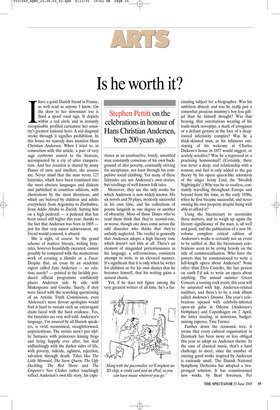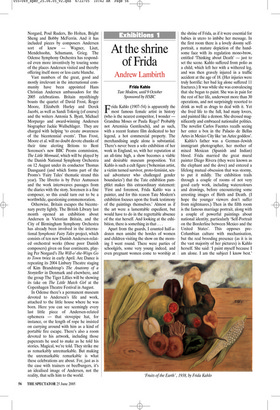Is he worth it?
Stephen Pettitt on the celebrations in honour of Hans Christian Andersen, born 200 years ago
Ihave a good Danish friend in France, as well read as anyone I know. On the door to her downstairs loo is fixed a spoof road sign. It depicts within a red circle and in instantly recognisable profiled caricature her country’s greatest national hero. A red diagonal stroke through it signifies prohibition. In this house we scarcely dare mention Hans Christian Andersen. When I tried to, in connection with this article, a pair of very sage eyebrows soared to the heavens, accompanied by a cry of utter exasperation. And her reaction is shared by many Danes of taste and intellect, she assures me. Never mind that the man wrote 127 fairytales, which have been translated into the most obscure languages and dialects and published in countless editions, with illustrations by the most illustrious, and which are beloved by children and adults everywhere from Argentina to Zimbabwe, from Addis Ababa to Zurich. Setting him on a high pedestal — a pedestal that has been raised still higher this year, thanks to the fact that Andersen was born in 1805 just for that very minor achievement, my friend would contend, is absurd.
She is right, of course. In the grand scheme of matters literary, writing fairytales, however beautifully executed, cannot possibly be compared with the momentous work of creating a Hamlet or a Faust. Despite that, an essay by an academic expert called Jens Andersen — no relation, surely? — printed in the lavishly produced official programme confidently places Andersen side by side with Shakespeare and Goethe. Surely, if they were faced with the searching questioning of an Artistic Truth Commission, even Andersen’s most devout apologists would find it hard to sustain such an extravagant claim faced with the hard evidence. Yes, the fairytales are very well told. Andersen’s language, I’m assured by all Danish speakers, is vivid, economical, straightforward, unpretentious. The stories aren’t just idyllic fantasies with princesses kissing frogs and living happily ever after, but deal unflinchingly with the darker sides of life, with poverty, ridicule, ugliness, rejection, salvation through death. Tales like The Little Mermaid, The Snow Queen, The Ugly Duckling, The Red Shoes and The Emperor’s New Clothes rather touchingly reflect Andersen’s own life story, his expe rience as an unattractive, lonely, unsettled man constantly conscious of his own background of dire poverty, constantly striving for acceptance, not least through his compulsive social climbing. Yet many of these fairytales are not Andersen’s own stories, but retellings of well-known folk tales.
Moreover, they are the only works for which Andersen is now widely known. His six novels and 50 plays, modestly successful in his own time, and his collections of poems languish in one degree or another of obscurity. Most of those Danes who’ve read them think that they’re second-rate, or worse, though one does come across the odd dissenter who thinks that they’re unfairly neglected. The verdict is generally that Andersen adopts a high literary tone which doesn’t suit him at all. There’s an element of misguided pretentiousness in his language, a self-conscious, consistent attempt to write in an elevated manner. It’s significant that it is only when he writes for children or for his own diaries that he becomes himself, that his writing gains a natural charm.
Yet, if he does not figure among the very greatest writers of all time, he’s a fas cinating subject for a biographer. Was his ambition absurd, and was he really just a somewhat precious mummy’s boy less gifted than he himself thought? Was that bearing, that ostentatious wearing of his trade-mark stovepipe, a mark of arrogance or a defiant gesture in the face of a deeprooted inferiority complex? Was he a thick-skinned man, as his infamous outstaying of his welcome at Charles Dickens’s house in 1857 would suggest, or acutely sensitive? Was he a repressed or a practising homosexual? (Certainly, there was never a deep, real relationship with a woman, and fuel is only added to the gay theory by his opera queen-like adoration of the singer Jenny Lind, the ‘Swedish Nightingale’.) Why was he so rootless, constantly travelling throughout Europe and beyond from the time, in the early 1830s, when he first became successful, and never owning his own property despite being well able to afford it?
Using the bicentenary to reconsider these matters, and to weigh up again the literary significance of the man, is all well and good, and the publication of a new 18volume complete critical edition of Andersen’s works is certainly not an event to be sniffed at. But the bicentenary celebrations seem to be erring heavily on the side of commercialisation. Who have the powers that be commissioned to write a full-length opera about Andersen? None other than Elvis Costello, the last person on earth I’d ask to write an opera about anything. The annual summer Green Concert, a touring rock event, this year will be saturated with hip, Andersen-related numbers, and there’s to be a rock album called Andersen’s Dreams. The year’s celebrations opened with celebrity-infested open-air galas in Odense (Andersen’s birthplace) and Copenhagen on 2 April, the latter starring, at notorious, budgetruining expense, Tina Turner.
Further down the economic tree, it seems that every cultural organisation in Denmark has been more or less obliged this year to adopt an Andersen theme. In the case of classical music, that’s a hard challenge to meet, since the number of existing good works inspired by Andersen is curiously small. The Danish National Symphony Orchestra has adopted a twopronged solution. It has commissioned new works, by Bent Sorensen, Per Norgard, Poul Ruders, Bo Holten, Bright Sheng and Bobby McFerrin. And it has included pieces by composers Andersen sort of knew — Wagner, Liszt, Mendelssohn, Schumann, Grieg. The Odense Symphony Orchestra has responded even more inventively by touring some of the places Andersen visited and thereby offering itself more or less carte blanche.
Vast numbers of the great, good and mostly irrelevant in the international community have been appointed Hans Christian Andersen ambassadors for the 2005 celebrations. Britain mystifyingly boasts the quartet of David Frost, Roger Moore, Elizabeth Hurley and Derek Jacobi, as well as Sandi Toksvig (of course) and the writers Antonia S. Byatt, Michael Morpurgo and award-winning Andersen biographer Jackie Wullschlager. They are charged with helping ‘to create awareness of the bicentennial events’. Thus Frost, Moore et al. will no doubt devote chunks of their time alerting Britons to Bent Sorensen’s new BBC Proms commission, The Little Mermaid, which will be played by the Danish National Symphony Orchestra on 12 August under its conductor Thomas Dausgaard (and which forms part of the Proms’s ‘Fairy Tales’ thematic strand this year). The libretto is by Peter Asmussen and the work interweaves passages from the diaries with the story. Sorensen is a fine composer, so this could turn out to be a worthwhile, questioning commemoration.
Otherwise, Britain escapes the bicentenary pretty lightly. The British Library last month opened an exhibition about Andersen in Victorian Britain, and the City of Birmingham Symphony Orchestra has already been involved in the international Symphonic Fairy Tales project, which consists of ten new Danish Andersen-related orchestral works (those poor Danish composers) given on four continents, playing Per Norgard’s The Will-o’-the-Wisps Go to Town twice in early April. Arc Dance is repeating its 2004 Linbury Theatre staging of Kim Brandstrup’s The Anatomy of a Storyteller in Denmark and elsewhere, and the group The Tiger Lillies will be showing its take on The Little Match Girl at the Copenhagen Theatre Festival in August.
In Odense there’s a permanent museum devoted to Andersen’s life and work, attached to the little house where he was born. Here you can see seemingly every last little piece of Andersen-related ephemera — that stovepipe hat, for instance, or the length of rope he insisted on carrying around with him as a kind of portable fire escape. There’s also a room devoted to his artwork, including those papercuts he used to make as he told his stories. Magical, we’re told. They strike me as remarkably unremarkable. But making the unremarkable remarkable is what these celebrations are about. For, just as is the case with trainers or beefburgers, it’s an idealised image of Andersen, not the reality, that sells him to the world.



































































 Previous page
Previous page